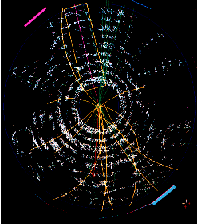"This is one of the ten most important accomplishments in this century in this
field," said Tom Trippe, a physicist in LBL's Physics Division and a member of
the DZero group.
"We were quite confident we had it last April, but we
were being conservative in our claims," said Lina Galtieri, who leads LBL
participation in the CDF group which announced the first evidence of the top
quark last April. At that time, the CDF group said it had strong case for the
top quark but lacked enough data to claim discovery. Since then, the CDF and
DZero groups have tripled the amount of data collected.
Nearly a thousand scientists from around the world took part in the CDF and the DZero
experiments, and LBL researchers made vital contributions to both
collaborations. Physicists and engineers at LBL designed a sophisticated
microchip for the Silicon Vertex Detector, an extremely high resolution
instrument at the heart of the CDF detector system that enabled precise
identification and tracking of bottom quarks, one the top quark's signature
decay products. The CDF's hadronic end calorimeter was also built at LBL.
The DZero group at LBL, which is led by Ron Madaras, was responsible for
designing, building, testing, and commissioning two critical components of the
DZero detector array: the Electromagnetic End Calorimeter which identifies and
measures the energies of electrons; and the Vertex Detector which detects the
tracks left by charged particles.
In announcing the discovery, project
spokespersons reported that the top quark has about the same mass as an atom of
gold or about 200 times the mass of a proton, making it by far the heaviest
elementary particle ever observed.
Top quarks exist only for an instant before decaying into a bottom quark and
a W boson, which means those created at
the birth of the universe are long gone. Even the Tevatron, the most powerful
collider in the world, has difficulty creating top quarks. It is estimated
that one pair of top quarks is produced for every 10 billion proton-antiproton
collisions. According to the Standard Model, however, the existence of the top
quark at creation was necessary along with the other five types of quarks. The
only types that have since survived in nature are the up and the down quarks,
the pair that make up the protons and neutrons in the nuclei of all the known
atoms in the universe.
-- Lynn Yarris
 After nearly two decades of searching, scientists have
declared that the top quark, the last of the six quarks predicted by the
Standard Model of particle physics and one of the fundamental building blocks
of matter, has been discovered. Both of the main experimental groups at
Fermilab's Tevatron collider -- the Collider Detector Facility (CDF) and the
DZero group -- have independently observed the production and decay of what had
been the crucial missing piece in the scientific picture of matter.
After nearly two decades of searching, scientists have
declared that the top quark, the last of the six quarks predicted by the
Standard Model of particle physics and one of the fundamental building blocks
of matter, has been discovered. Both of the main experimental groups at
Fermilab's Tevatron collider -- the Collider Detector Facility (CDF) and the
DZero group -- have independently observed the production and decay of what had
been the crucial missing piece in the scientific picture of matter. 
 Return to Highlights Table of Contents
Return to Highlights Table of Contents